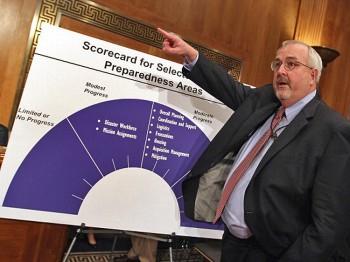“America’s Health Rankings” released its 21st annual comprehensive state-by-state report of our nation’s health last week. The purpose of the report is to understand and improve the health of Americans.
This is the longest running report of its kind and is published jointly by the United Health Foundation, the America Public Health Association, and Partnership for Prevention.
According to its americashealthrankings.org website, the report is an analysis of how healthy or unhealthy each state is, using historical and comprehensive health, environmental, and socio-economic data from credible outside sources such as the CDC, AMA, the Department of Education, and the Census Bureau. A scientific advisory committee from leading academic, government, and private entities oversees it.
Its goal, besides determining certain national health benchmarks and ranking states, is to “educate America and stimulate individuals, elected officials, health professionals, employers, and communities to take action to improve health in individual states and across the nation.”
The 2010 edition ranked Vermont, Massachusetts, New Hampshire, and Hawaii as the healthiest states, with Vermont being the top state four years in a row.
Massachusetts has ranked in the top 10 states for the past 20 years. Mississippi is at the bottom, ranked 50th, with Louisiana, Arkansas, Nevada, and Oklahoma rounding out the bottom five states. The rankings are considered benchmarks and many states use them as reference points in their annual reviews. Organizations use the rankings as goals in their health improvement programs.
Vermont was noted for its high rates of graduation from high school, ready access to prenatal care, wide health insurance coverage, few children in poverty, availability of primary care physicians, and public health spending.
The rankings are derived from 22 critical measures of two types—determinants and outcomes. Determinants are actionable factors that affect the future health of the population, whereas outcomes represent what has already occurred such as mortality rate or poor mental health days.
Determinants are further divided into behavioral, community and environmental, public and health policy, level of clinical care, chronic disease, or economic factors that can affect the overall health of a population.
The 21 years of study present a unique view of our nation’s overall health over time. It has improved by 21.3 percent, due primarily to the reduction in infant mortality, infectious disease, smoking, cardiovascular deaths, and violent crime, but the improvement was offset by a rapid increase in obesity and diabetes in recent years, the persistently high rate of people who are uninsured, and an increase in the percentage of children in poverty.
The report included a commentary by the surgeon general saying the five leading causes of death remain heart disease, cancer, stroke, chronic lower respiratory disease, and unintentional injuries, which “account for nearly two-thirds of all deaths in the United States.”
“By now it should be clear to all of us that the most effective approach to addressing the leading causes of death is to reduce preventable risk factors, especially physical inactivity, poor nutrition, tobacco use, and underage and excessive alcohol use,” the surgeon general stated.
In terms of international comparison, although the United States spends more than other countries on health care we continue to decline in national collective health. Thirty other developed countries have a higher healthy life expectancy than we do. Our infant mortality is more than double that of other developed countries. Our homicide rate ranks 29th of 31 countries.
America’s Health Rankings recommends that “each of us can directly improve our nation’s collective health by learning about the factors that affect our health and taking real action to improve our habits, culture and environment.”
This is the longest running report of its kind and is published jointly by the United Health Foundation, the America Public Health Association, and Partnership for Prevention.
According to its americashealthrankings.org website, the report is an analysis of how healthy or unhealthy each state is, using historical and comprehensive health, environmental, and socio-economic data from credible outside sources such as the CDC, AMA, the Department of Education, and the Census Bureau. A scientific advisory committee from leading academic, government, and private entities oversees it.
Its goal, besides determining certain national health benchmarks and ranking states, is to “educate America and stimulate individuals, elected officials, health professionals, employers, and communities to take action to improve health in individual states and across the nation.”
The 2010 edition ranked Vermont, Massachusetts, New Hampshire, and Hawaii as the healthiest states, with Vermont being the top state four years in a row.
Massachusetts has ranked in the top 10 states for the past 20 years. Mississippi is at the bottom, ranked 50th, with Louisiana, Arkansas, Nevada, and Oklahoma rounding out the bottom five states. The rankings are considered benchmarks and many states use them as reference points in their annual reviews. Organizations use the rankings as goals in their health improvement programs.
Vermont was noted for its high rates of graduation from high school, ready access to prenatal care, wide health insurance coverage, few children in poverty, availability of primary care physicians, and public health spending.
The rankings are derived from 22 critical measures of two types—determinants and outcomes. Determinants are actionable factors that affect the future health of the population, whereas outcomes represent what has already occurred such as mortality rate or poor mental health days.
Determinants are further divided into behavioral, community and environmental, public and health policy, level of clinical care, chronic disease, or economic factors that can affect the overall health of a population.
The 21 years of study present a unique view of our nation’s overall health over time. It has improved by 21.3 percent, due primarily to the reduction in infant mortality, infectious disease, smoking, cardiovascular deaths, and violent crime, but the improvement was offset by a rapid increase in obesity and diabetes in recent years, the persistently high rate of people who are uninsured, and an increase in the percentage of children in poverty.
The report included a commentary by the surgeon general saying the five leading causes of death remain heart disease, cancer, stroke, chronic lower respiratory disease, and unintentional injuries, which “account for nearly two-thirds of all deaths in the United States.”
“By now it should be clear to all of us that the most effective approach to addressing the leading causes of death is to reduce preventable risk factors, especially physical inactivity, poor nutrition, tobacco use, and underage and excessive alcohol use,” the surgeon general stated.
In terms of international comparison, although the United States spends more than other countries on health care we continue to decline in national collective health. Thirty other developed countries have a higher healthy life expectancy than we do. Our infant mortality is more than double that of other developed countries. Our homicide rate ranks 29th of 31 countries.
America’s Health Rankings recommends that “each of us can directly improve our nation’s collective health by learning about the factors that affect our health and taking real action to improve our habits, culture and environment.”




